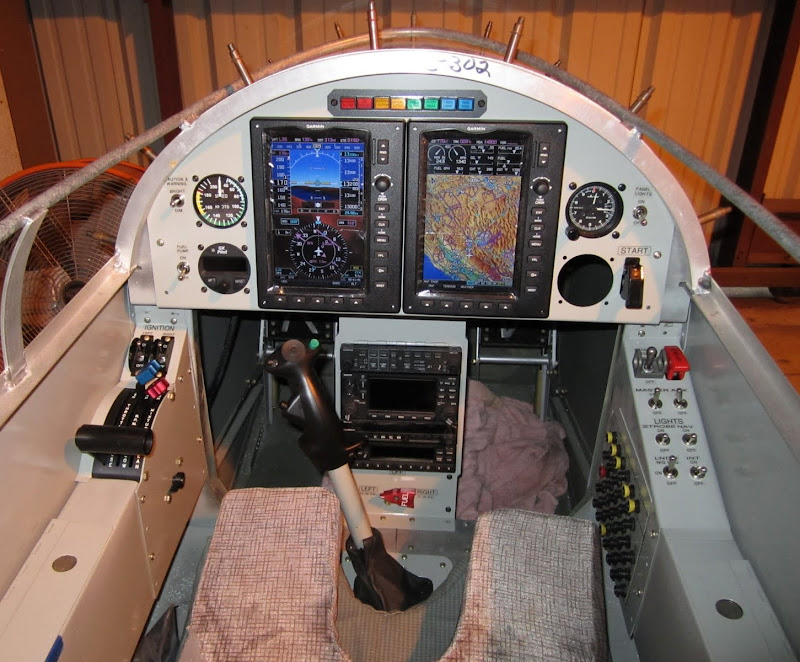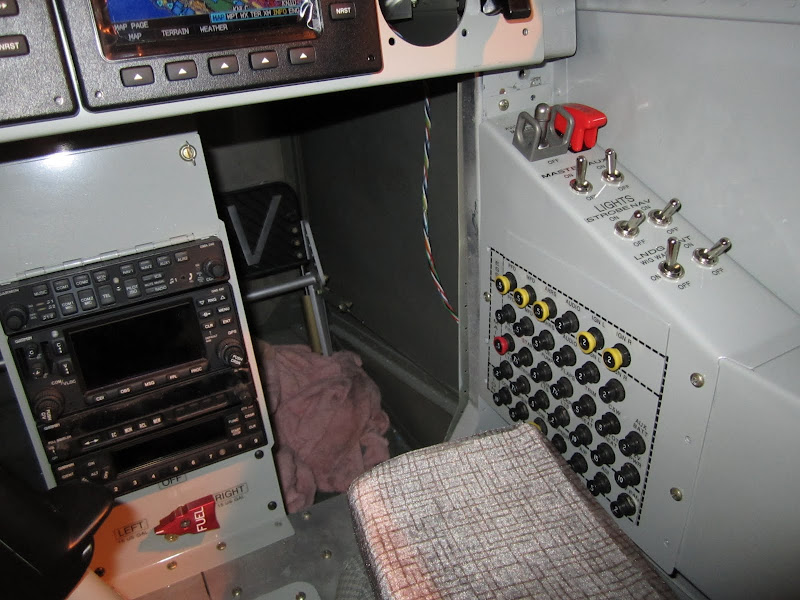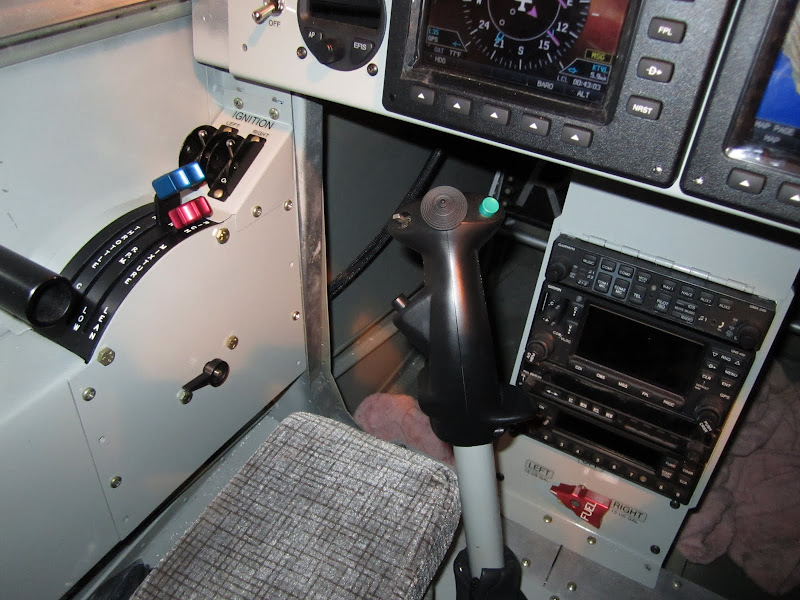One of the things that it sometimes awhile to get across to new builders is that if you want to finish an airplane project, you will find that progress has to be measured in millimeters. There is a list of tasks that must be completed to get to first flight, and until they are all done, it doesn?t make any difference if they are large or small ? nothing flies until it all flies. I remind myself of it during weeks like this when I spent most of my shop hours doing panel painting and labels. No, I didn?t mount the wings, now, I didn?t hang the engine ? or plumb it, or put the gear on?..but those things will come in their turn. My next major milestone is wiring the panel and cockpit so that all that is complete before the airplane gets ?taller? and harder to work on. And in order to wire, you need to have everything in place. To have everything in place, it helps to have everything painted ? and if you?re painting, why not get the labels done as well? Before you know it, the cockpit looks complete (even though nothing is truly functional). So?time to show a little of what our RV-3 will look like from the pilot?s perspective!
It has been a fun and interesting challenge to fit everything we needed to support a safe, redundant IFR package into such a small airplane. The G3X screens obviously dominate the panel, along with the G3Pilot and the hole on the lower right is where a TT ADI will go. The main panel has minimum number of switches ? the fuel pump is right where your hand falls naturally while on the throttle, and the Starter switch is there for your right hand. Panel lighting and a dimmer switch for the annunciator panel are the only other ones ? right where you want them when going for panel lights. The canopy bow takes away a ?? wide strip of useful panel ? a significant portion of an already small panel, and had to be considered carefully during the design. The side console got Camlocs for latches this week, and we are hoping to add the ?Fatboy? throttle handle in the near future. The screens are powered in ?demo? mode with a temporary harness ? nothing else is wired up yet.

The Garmin boxes have redundant power feeds built in, so that necessitated a dual-bus system, and extra circuit breakers to support the architecture. I used the compact Klixon breakers to maximize breakers in minimum space, and am satisfied the way the electrical panel turned out. Basically, the entire electrical system (busses, switches, isolation diodes) resides in that panel, along with lighting switches. Labeling isn?t quite complete, but far enough along to show. For me, breakers are much handier than fuses for a glass cockpit airplane, since a lot of time is spent doing configuration work which requires power cycles. It?s not about the flying (I almost never reset popped breakers during flight!), it?s about the maintenance!

The throttle quadrant is pretty much done except for the cables themselves ? that should be typically frustrating, trying to fit three cables through the center section bulkhead with any structure left at all! The ignition switches found their natural place all by themselves ? some problems just solve themselves! As noted above, we?ll be trying to incorporate a new throttle lever ? assuming it fits, it will have a PTT in addition to the one on the stick. The stick will have the usual array of switches, including flaps, trim, PTT, autopilot CWS switch, etc. The stick boot was left over from my RV-8 interior ? never did figure out how to mount a forward stick boot on that airplane! The radio stack is both visible and reachable from a comfortable sitting position ? I am surprised myself how nice that turned out from a human factors perspective.

I guess that now that the ?art project? of cockpit layout is complete, it is time to dig out the avionics schematics and build some wiring harnesses ? then we?ll see if I can keep all the magic smoke installed per the factory configuration drawings?.
Paul
It has been a fun and interesting challenge to fit everything we needed to support a safe, redundant IFR package into such a small airplane. The G3X screens obviously dominate the panel, along with the G3Pilot and the hole on the lower right is where a TT ADI will go. The main panel has minimum number of switches ? the fuel pump is right where your hand falls naturally while on the throttle, and the Starter switch is there for your right hand. Panel lighting and a dimmer switch for the annunciator panel are the only other ones ? right where you want them when going for panel lights. The canopy bow takes away a ?? wide strip of useful panel ? a significant portion of an already small panel, and had to be considered carefully during the design. The side console got Camlocs for latches this week, and we are hoping to add the ?Fatboy? throttle handle in the near future. The screens are powered in ?demo? mode with a temporary harness ? nothing else is wired up yet.
The Garmin boxes have redundant power feeds built in, so that necessitated a dual-bus system, and extra circuit breakers to support the architecture. I used the compact Klixon breakers to maximize breakers in minimum space, and am satisfied the way the electrical panel turned out. Basically, the entire electrical system (busses, switches, isolation diodes) resides in that panel, along with lighting switches. Labeling isn?t quite complete, but far enough along to show. For me, breakers are much handier than fuses for a glass cockpit airplane, since a lot of time is spent doing configuration work which requires power cycles. It?s not about the flying (I almost never reset popped breakers during flight!), it?s about the maintenance!
The throttle quadrant is pretty much done except for the cables themselves ? that should be typically frustrating, trying to fit three cables through the center section bulkhead with any structure left at all! The ignition switches found their natural place all by themselves ? some problems just solve themselves! As noted above, we?ll be trying to incorporate a new throttle lever ? assuming it fits, it will have a PTT in addition to the one on the stick. The stick will have the usual array of switches, including flaps, trim, PTT, autopilot CWS switch, etc. The stick boot was left over from my RV-8 interior ? never did figure out how to mount a forward stick boot on that airplane! The radio stack is both visible and reachable from a comfortable sitting position ? I am surprised myself how nice that turned out from a human factors perspective.
I guess that now that the ?art project? of cockpit layout is complete, it is time to dig out the avionics schematics and build some wiring harnesses ? then we?ll see if I can keep all the magic smoke installed per the factory configuration drawings?.
Paul




